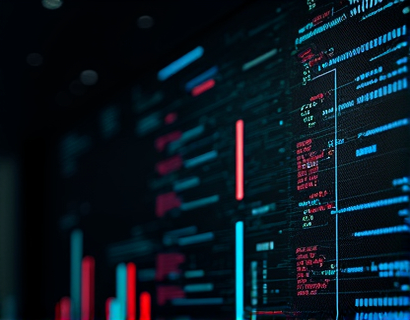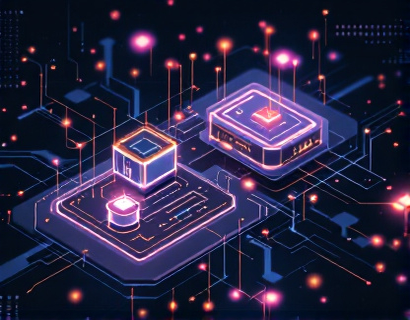Mastering Digital Currency Creation: A Guide to Cutting-Edge Software for Businesses and Blockchain Innovators
In the rapidly evolving landscape of blockchain technology, the ability to create and manage digital currencies has become an essential skill for businesses and innovators. This guide delves into the advanced software tools that empower users to master digital currency creation, offering unparalleled customization, robust security, and seamless scalability. The aim is to make blockchain technology accessible and manageable for both novices and experts, streamlining the complex process of digital currency development.
The journey into digital currency creation begins with understanding the fundamental components of blockchain technology. At its core, a blockchain is a decentralized ledger that records transactions across multiple computers in such a way that the registered transactions cannot be altered retroactively. This inherent transparency and security make it an ideal platform for creating digital currencies. However, building a blockchain from scratch requires extensive knowledge in cryptography, distributed systems, and consensus mechanisms.
To bridge this knowledge gap, specialized software solutions have emerged, designed to simplify the process of digital currency creation. These tools provide a user-friendly interface that abstracts the complex underlying technology, allowing users to focus on customization and innovation. The first step in using such software is to select a suitable blockchain framework that aligns with your project's goals and requirements.
Choosing the Right Blockchain Framework
The choice of blockchain framework is crucial as it forms the foundation of your digital currency. Popular frameworks include Ethereum, Hyperledger Fabric, and Corda, each offering unique features and capabilities. Ethereum, for instance, is known for its smart contract functionality, making it ideal for creating complex digital currencies with automated rules and conditions. Hyperledger Fabric, on the other hand, is designed for enterprise solutions, emphasizing privacy and scalability.
When selecting a framework, consider factors such as the level of customization required, the target audience, and the intended use case. For businesses looking to create a private blockchain for internal use, a framework like Hyperledger Fabric may be more appropriate. For public blockchains aimed at a broader user base, Ethereum's extensive ecosystem and community support make it a compelling choice.
Once the framework is selected, the next step is to set up the development environment. This involves installing the necessary software, setting up a virtual machine or cloud-based infrastructure, and configuring the development tools. Most frameworks provide detailed documentation and starter kits to facilitate this process, ensuring that even those with limited technical expertise can get started.
Designing the Digital Currency
With the environment set up, the focus shifts to designing the digital currency itself. This involves defining key parameters such as the currency's name, symbol, and total supply. The software tools provide interfaces to set these parameters, ensuring that the currency is well-defined and consistent with your project's vision.
One of the most critical aspects of digital currency design is the creation of the token or coin. This involves writing smart contracts that govern the behavior of the currency, including transaction rules, mining mechanisms, and reward distributions. For example, in an Ethereum-based system, smart contracts written in Solidity can define the logic for minting, transferring, and validating transactions.
Customization is a key feature of advanced digital currency software. Users can tailor the currency to meet specific needs, such as implementing a deflationary model where the currency supply decreases over time, or creating a utility-based token that grants access to specific services or platforms. The software tools offer a range of templates and examples to guide users through this process, making it easier to create unique and functional digital currencies.
Ensuring Robust Security
Security is paramount in the world of digital currencies. Advanced software solutions incorporate multiple layers of security to protect the currency and its transactions. This includes the use of cryptographic algorithms for hashing and signing transactions, as well as implementing consensus mechanisms that ensure the integrity of the blockchain.
Consensus mechanisms such as Proof of Work (PoW) and Proof of Stake (PoS) play a crucial role in maintaining the security and decentralization of the blockchain. PoW, used by Bitcoin, requires miners to solve complex mathematical puzzles, making it computationally expensive to alter the blockchain. PoS, on the other hand, selects validators based on the number of coins they hold and are willing to "stake" as collateral, reducing the computational requirements and energy consumption.
Additionally, the software tools provide features like multi-signature wallets, cold storage options, and regular security audits to further enhance the security of the digital currency. These measures help protect against common threats such as hacking, fraud, and unauthorized access, giving users confidence in the security of their assets.
Scalability and Performance
As the digital currency gains traction, scalability becomes a critical consideration. Advanced software solutions are designed to handle increasing transaction volumes and user bases without compromising performance. This involves optimizing the blockchain's architecture, implementing sharding techniques, and leveraging off-chain solutions to improve throughput and reduce latency.
Sharding, for example, involves dividing the blockchain into smaller, more manageable parts called shards, each processing a subset of transactions. This parallel processing capability significantly enhances the blockchain's capacity to handle a large number of transactions simultaneously. Off-chain solutions, such as state channels and sidechains, allow for faster and cheaper transactions by moving certain operations outside the main blockchain.
The software tools provide built-in support for these scalability features, allowing developers to implement them seamlessly. This ensures that the digital currency can grow and adapt to changing demands, maintaining high performance and reliability over time.
User Interface and Experience
A user-friendly interface is essential for the adoption and success of a digital currency. Advanced software solutions offer customizable user interfaces that can be tailored to the target audience's needs. This includes designing intuitive wallets, dashboards, and transaction interfaces that are easy to navigate and understand.
For novices, a simplified interface with clear instructions and guided processes can help reduce the learning curve. For experts, more advanced features and customization options allow for greater control and flexibility. The software tools provide a range of design templates and components to help create a cohesive and professional user experience.
Deployment and Maintenance
Once the digital currency is designed and tested, the next step is deployment. This involves deploying the blockchain network, setting up nodes, and initializing the currency supply. The software tools simplify this process with deployment scripts and management interfaces, ensuring a smooth and error-free deployment.
After deployment, ongoing maintenance is crucial to ensure the continued health and security of the blockchain. This includes monitoring network activity, updating software components, and addressing any issues that arise. The software tools often include monitoring dashboards and alert systems to help maintainers stay informed and responsive.
Regular updates and upgrades are also important to incorporate new features, improve performance, and enhance security. The software solutions provide version control and update mechanisms, making it easier to manage the lifecycle of the digital currency.
Community and Ecosystem
Building a strong community around the digital currency is vital for its long-term success. Advanced software solutions often come with built-in tools for community management, including forums, chat platforms, and social media integrations. These tools help foster engagement, gather feedback, and build a loyal user base.
Additionally, integrating with other blockchain projects and services can expand the currency's ecosystem. This includes supporting interoperability protocols and partnerships with complementary platforms, enabling users to interact with a broader range of services and assets.
By leveraging these community and ecosystem tools, developers can create a vibrant and supportive environment that encourages adoption and innovation.
Conclusion
Mastering digital currency creation with advanced software tools empowers businesses and blockchain innovators to enter the space with confidence. These tools provide unparalleled customization, robust security, and seamless scalability, making blockchain technology accessible and manageable. By following the steps outlined in this guide, users can navigate the complex process of digital currency development and successfully launch their own currencies in the dynamic world of blockchain.










































